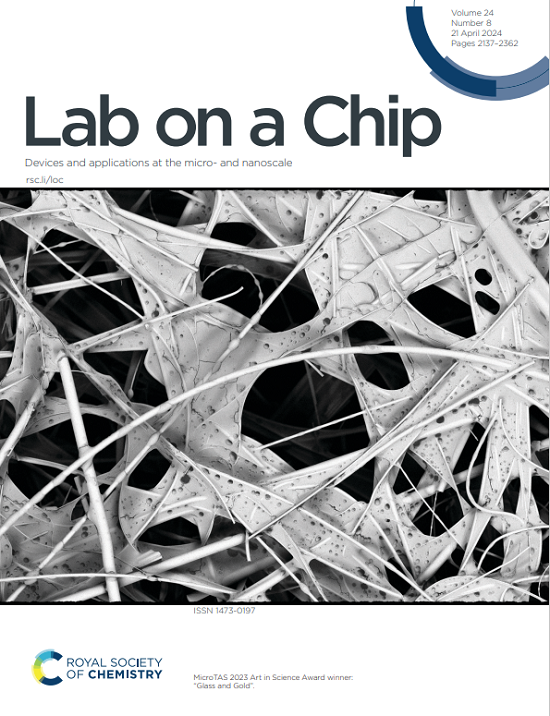A microfluidic co-culture model for investigating colonocytes-microbiota interactions in colorectal cancer
IF 6.1
2区 工程技术
Q1 BIOCHEMICAL RESEARCH METHODS
引用次数: 0
Abstract
Changes in the abundance of certain bacterial species within the colorectal microbiota correlate with colorectal cancer (CRC) development. While carcinogenic mechanisms of single pathogenic bacteria have been characterized in vitro, limited tools are available to investigate interactions between pathogenic bacteria and both commensal microbiota and colonocytes in a physiologically relevant tumor microenvironment. To address this, we developed a microfluidic device that can be used to co-culture colonocyte spheroids and colorectal microbiota. The device was used to explore the effect of Fusobacterium nucleatum, an opportunistic pathogen associated with colorectal cancer development in humans, on colonocyte gene expression and microbiota composition. F. nucleatum altered the transcription of genes involved in cytokine production, epithelial-to-mesenchymal transition, and proliferation in colonocytes in a contact-independent manner; however, most of these effects were significantly diminished by the presence of commensal microbiota. Interestingly, F. nucleatum significantly altered the abundance of multiple bacterial clades associated with mucosal immune responses and cancer development in the colon. Our results highlight the importance of evaluating the potential carcinogenic activity of pathogens in the context of a commensal microbiota, and the potential to discover novel inter-species microbial interactions in the CRC microenvironment.用于研究结肠癌中结肠细胞与微生物群相互作用的微流控共培养模型
结肠直肠微生物群中某些细菌物种丰度的变化与结肠直肠癌(CRC)的发展相关。虽然单一致病菌的致癌机制已在体外得到表征,但用于研究肿瘤微环境中致病菌与共生微生物群和结肠细胞之间相互作用的工具却很有限。为了解决这个问题,我们开发了一种微流控装置,可用于共同培养结肠细胞球和结肠直肠微生物群。该装置用于探索核酸镰刀菌(一种与人类结直肠癌发展相关的机会性病原体)对结肠细胞基因表达和微生物群组成的影响。核酸镰刀菌以一种与接触无关的方式改变了结肠细胞中涉及细胞因子产生、上皮细胞向间质转化和增殖的基因转录;然而,这些影响大多因共生微生物群的存在而显著减弱。有趣的是,F. nucleatum 能显著改变与结肠粘膜免疫反应和癌症发展相关的多个细菌支系的丰度。我们的研究结果突显了在共生微生物群的背景下评估病原体潜在致癌活性的重要性,以及发现 CRC 微环境中新的微生物种间相互作用的潜力。
本文章由计算机程序翻译,如有差异,请以英文原文为准。
求助全文
约1分钟内获得全文
求助全文
来源期刊

Lab on a Chip
工程技术-化学综合
CiteScore
11.10
自引率
8.20%
发文量
434
审稿时长
2.6 months
期刊介绍:
Lab on a Chip is the premiere journal that publishes cutting-edge research in the field of miniaturization. By their very nature, microfluidic/nanofluidic/miniaturized systems are at the intersection of disciplines, spanning fundamental research to high-end application, which is reflected by the broad readership of the journal. Lab on a Chip publishes two types of papers on original research: full-length research papers and communications. Papers should demonstrate innovations, which can come from technical advancements or applications addressing pressing needs in globally important areas. The journal also publishes Comments, Reviews, and Perspectives.
 求助内容:
求助内容: 应助结果提醒方式:
应助结果提醒方式:


